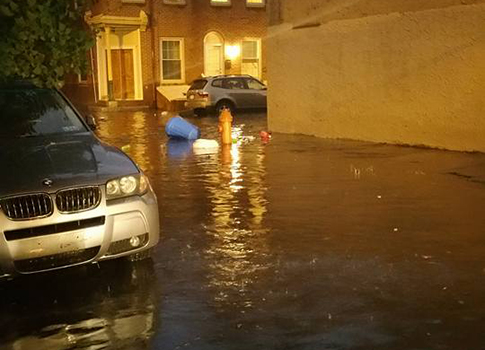For our final Infrastructure Week post, we are looking at a massive, multi-year project that will help reduce flooding related to heavy rains in several neighborhoods. Like many other cities, Philadelphia is dealing with a sewer system designed for a time when there were far fewer hard surfaces like streets, parking lots and buildings.
Because those surfaces don’t absorb rain, the water becomes stormwater runoff, which can overwhelm sewers, leading to localized flooding and combined sewer overflows. While the City is relying on Green Stormwater Infrastructure investments made through the Green City, Clean Waters program to deal with this challenge, those green tools are more effective when we also improve our traditional sewer system.
A good example of an investment in our existing system that will enhance Green City, Clean Waters projects is the Cohocksink Storm Flood Relief project, also called the Northern Liberties SFR. The project is named after the Cohocksink Creek, which once flowed through Kensington and Northern Liberties and emptied into the Delaware River not far from where SugarHouse Casino stands today.
Like many small streams in Philadelphia, the Cohocksink was covered over and integrated into the sewer system in the mid to late 1800s.
Today, the Cohocksink sewer system must manage stormwater drainage from more than 1,000 acres of urban land.
To get the inside scoop on the Cohocksink improvements, we put a few questions to project manager Bill Dobbins, an engineer who has worked with Philadelphia Water since 2001.
Watersheds Blog: What is the purpose of the Cohocksink Storm Flood Relief project? What work needs to be done to accomplish this?
BD: The purpose of the approximately $43.5 million Cohocksink Storm Flood Relief project (CSFR) is to minimize flooding on streets and properties by increasing the capacity of the sewer infrastructure that manages stormwater and wastewater in Northern Liberties and South Kensington. When the work is done, we will have doubled the capacity of the system.
CSFR offers a range of environmental, aesthetic, financial, safety, and quality of life benefits:
- Increased reliability of sewer service
- Reduced risk of flooding
- Reduced pollution in local waterways
- Restoration of sidewalks, curbs, and streets
- Installation of new ADA-compliant ramps and pavement
- Cleaner air and improved, greener streetscapes provided through Green Streets components, such as recessed planter beds
- Minimal service disruptions thanks to ongoing coordination with SEPTA, PECO, PGW, and telecommunications companies
CSFR is a six-phase project, and includes the installation of over one mile of box sewer (square concrete sewers), pipe sewers of various diameters (from one foot to five feet) and large underground chambers. The box sewers being constructed are very large; for example, one section includes three 11-foot by 11-foot boxes, and some portions include 15-foot by 12-foot box sewer.
Watersheds Blog: When did Philadelphia Water start working on the project? Where are we in the process? When do we expect the work to be finished?
BD: Planning started around 2004. Hydraulic modeling—using computers to study the flow of water—was conducted in response to intense rain events that caused flooding. Various configurations for new or enlarged piping were evaluated and conceptually laid out. The best solution was determined, and design began. The first phase was constructed in 2010. Phases 2, 3 and 4 were constructed from 2014-2016. Phase 5 will begin in this year, and Phase 6 will begin in 2018. Construction will be complete by 2020.
Watersheds Blog: Can you give an estimate of how many people are needed to do a job of this size?
BD: We estimated job creation for the entire program at about 262 full-time jobs, or “Full-Time Equivalents.” The remaining phases, which involve three new stormwater chambers and 2,900 feet of box sewer, should create just over 100 full-time positions. Phase 3 alone created over 100 full-time jobs.
Watersheds Blog: From an engineering perspective, what challenges have you experienced?
BD: One of the biggest challenges on this project is coordinating utilities. The proposed sewers are so large that there is not much room for electric, gas, or other utilities in the street.
So, not only did the other utilities need to be moved out of the way, but it was difficult to find space in the street for them, and so some had to be rerouted.
Another challenge was managing the flow in the existing, active sewer in order to construct the new one. You can’t stop it from raining while you work, so that water has to be managed even as you build the new sewer.
Lastly, managing traffic around the site and coordinating traffic within the neighborhood, in conjunction with work being done on I-95 by PennDOT, was a challenge. We’re very grateful to the residents who have worked with us throughout.
Watersheds Blog: What makes this infrastructure project unique?
BD: The size of this infrastructure investment and the piping really makes it stand out. In addition to the large box sewers mentioned earlier, we have one chamber for conveying stormwater that is 50 feet wide and 200 feet long—that’s huge, and it will be able to handle a lot of water.
Watersheds Blog: Do concrete box sewers have an advantage over the existing, arched brick sewers?
BD: The new square sewers have multiple benefits. They take full advantage of the hole created during excavation, and they provide more flow than circular sewers. Given the process of pouring the concrete, square-forming is the most practical method.
Since they are constructed of reinforced concrete, they don’t need the arch support that a brick sewer would.
Also, the box sewers are being constructed next to the existing brick arch sewers, which will remain in several places, and they are really an addition that will take the pressure off the existing system.
Watersheds Blog: Does a project this big require you to use special technology and tools?
BD: We have the project drawn in 3D and we used laser scanning to survey the project site. Compared to 2-dimensional CAD (computer-aided design) and traditional survey techniques, 3D helps in demonstrating the intricate layers of the design and other critical components. This advanced understanding of key aspects creates a better project simply because of the emphasis we can put on critical aspects.
Watersheds Blog: What’s the most rewarding part of working on a big water infrastructure project like this?
BD: The most rewarding part? Seeing the project completed and knowing that, when it rains, these neighborhoods will drain well and be better protected from street flooding. It’s a long and disruptive process, but it will really help these neighborhoods and the people who live there.
The Watersheds Blog thanks Bill and the people that are making this project a success. Be sure to check out the rest of our Infrastructure Week 2016 coverage:




